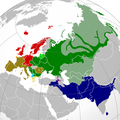Datei:Indo-European branches map.png
Erscheinungsbild

Grate faan detdiar föörskaubil: 599 × 600 pixel. Ööder apliasangen: 240 × 240 pixel | 479 × 480 pixel | 767 × 768 pixel | 1.023 × 1.024 pixel | 2.045 × 2.048 pixel | 2.934 × 2.938 pixel.
Originaal datei (2.934 × 2.938 pixels, dateigrate: 1,91 MB, MIME-typ: image/png)
Datei wersioonen
Klike üüb en tidjponkt, am detdiar wersion uuntulukin.
| Dootem/Tidj | Föörskaubil | Miaten | Brüker | Komentaar | |
|---|---|---|---|---|---|
| aktuel | 10:28, 7. Jun. 2024 |  | 2.934 × 2.938 (1,91 MB) | Golden | update Karabakh |
| 04:43, 26. Sep. 2022 |  | 2.934 × 2.938 (2,16 MB) | Alexikoua | minor fixes | |
| 16:58, 30. Mar. 2022 |  | 2.934 × 2.938 (1,74 MB) | Whoop whoop pull up | Whoops, wrong file! | |
| 16:37, 30. Mar. 2022 |  | 2.048 × 2.048 (980 KB) | Whoop whoop pull up | Misc fixes (Russian minority in Svalbard & Israel, Slovenian in SE Carinthia, Greek in N Epirus, Aromanians/Megleno-Romanians, Swedish essentially extinct in Estonia, etc. | |
| 10:37, 22. Det. 2021 |  | 2.934 × 2.938 (1,74 MB) | Ahmet Q. | Reverted to version as of 19:55, 23 August 2021 (UTC)seek consensus for your changes | |
| 21:40, 25. Nof. 2021 |  | 2.934 × 2.938 (2,16 MB) | Alexikoua | rv elimination of Greek minority in Albania | |
| 20:55, 23. Aug. 2021 |  | 2.934 × 2.938 (1,74 MB) | Ahmet Q. | Rv false edit summary. Overrepresentation of Greeks in Turkey, Albania and Ukraine. Unexplained removal of Romanian in Serbia. Overall deterioration of the original file. Seek consensus for your changes. | |
| 17:16, 7. Aug. 2021 |  | 2.934 × 2.938 (2,16 MB) | Demetrios1993 | Addition of Arbereshe linguistic minority in Sicily. Addition of Serbian, Bosnian, and Gorani linguistic minorities in Kosovo. Addition of Greek linguistic minorities in Italy, Albania, Turkey, and Ukraine. Including some other minor corrections. | |
| 18:00, 19. Nof. 2020 |  | 2.934 × 2.938 (1,74 MB) | Golden | update Armenian | |
| 19:42, 31. Mar. 2018 |  | 1.479 × 1.479 (574 KB) | Maphobbyist | Removed area that exactly corresponds to the non-Indo European Lezgi linguistic area. |
Hü det datei brükt woort
Jodiar 2 sidjen brük detdiar datei:
Globaal brük faan datein
Jodiar ööder Wikis brük detdiar datei:
- Brük üüb ast.wikipedia.org
- Brük üüb ban.wikipedia.org
- Brük üüb be-tarask.wikipedia.org
- Brük üüb be.wikipedia.org
- Brük üüb bg.wikipedia.org
- Brük üüb cs.wikipedia.org
- Brük üüb da.wikipedia.org
- Brük üüb de.wikipedia.org
- Brük üüb en.wikipedia.org
- Brük üüb en.wikiversity.org
- Brük üüb es.wikipedia.org
- Brük üüb et.wikipedia.org
- Brük üüb eu.wikipedia.org
- Brük üüb fa.wikipedia.org
- Brük üüb fi.wikipedia.org
- Brük üüb fr.wikipedia.org
- Brük üüb gl.wikipedia.org
- Brük üüb gu.wikipedia.org
- Brük üüb gv.wikipedia.org
- Brük üüb hak.wikipedia.org
- Brük üüb he.wikipedia.org
- Brük üüb hy.wikipedia.org
- Brük üüb hyw.wikipedia.org
- Brük üüb ilo.wikipedia.org
- Brük üüb incubator.wikimedia.org
- Brük üüb io.wikipedia.org
- Brük üüb it.wikipedia.org
- Brük üüb ja.wikipedia.org
Muar globaal brük faan detdiar datei.



